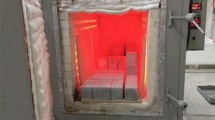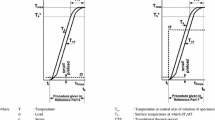Abstract
This paper investigates the effect of elevated temperature on the flexural strength (FS) and split cylinder strength (SCS) of high strength concrete (HSC). Four concrete mixes of 50, 90, 110, and 130 MPa grade were prepared and subjected to elevated temperature exposure of 200°C and 400°C, and cooled under slow and quick cooling conditions. In addition, 130 MPa grade concrete specimens were also subjected to 100°C and 600°C exposure temperatures to compare FS and SCS under elevated temperatures. It was observed that with the increase in the elevated temperature, the FS and SCS experienced significant losses. The loss was found to be higher for richer concretes. FS was observed to experience a sharp loss at low temperatures that became gradual later at high temperatures. SCS, however, experienced a gradual loss, though sharper than FS, with the increase in temperature. The results indicated that cooling had a significant effect on the residual values and quick cooling caused greater loss in FS and SCS, than slow cooling at elevated temperatures. The quick cooling was noted to produce maximum loss over slow cooling at temperatures around 400°C.
Similar content being viewed by others
References
A.E. Ahmed, A.H. Al-Shaikh, and A.I. Arafat, “Residual Compressive Strength and Bond Strengths of Limestone Aggregate Concrete Subjected to Elevated Temperatures,” Magazine of Concrete Research, vol. 44, Issue 159, 1992, pp. 117–125.
R.V. Balendran, T. Maqsood, and A. Nadeem, “Effect of Cooling Method on Residual Compressive Strength of High Strength Concrete Cured for 28 Days and 180 Days and Heated to Elevated Temperatures,” in Proceedings of the 26th conference on Our World in Concrete and Structures, C.T. Tam Ed., August 27–28 2001, Singapore, pp. 183–190.
Z.P. Bazant and M.F. Kaplan, Concrete at High Temperatures: Material Properties and Mathematical Models, Longman Group Limited, Essex, England, p. 45, 1996.
G.G. Carette, K.E. Painter, and V.M. Malhotra, “Sustained High Temperature Effect on Concrete Made with Normal Portland Cement, Normal Portland Cement and Slag, or Normal Portland Cement and Fly Ash,” in Concrete International: Design and Construction, vol. 4.,no. 7, 1982, pp. 41–51.
C. Castillo and A.J. Durrani, “Effect of Transient High Temperature on High-Strength Concrete,” ACI Materials Journal, vol. 87,no. 1, 1990, pp. 47–53.
S.Y.N. Chan, G.F. Peng, and K.W. Chan, “Comparison Between High Strength Concrete and Normal Strength Concrete Subjected to High Temperature,” Materials & Structures, vol. 29, 1996, pp. 616–619.
Y.N. Chan, X. Luo, and W. Sun, “Compressive Strength and Pore Structure of High-Performance Concrete After Exposure to High Temperature up to 800°C,” Cement and Concrete Research, vol. 30,no. 2, 2000, pp. 247–251.
D.N. Crook and M.J. Murray, “Regain of Strength and Firing of Concrete,” Magazine of Concrete Research, vol. 22, issue 72, 1970, pp. 149–154.
H.S. Davis, “Effect of High Temperature Exposure on Concrete,” Materials Research and Standards, vol. 7,no. 10, 1967, pp. 452–459.
H.S. Davis, “N-Reactor Shielding,” International Seminar on Concrete for Nuclear Reactors, ACI Special Publication No. 34, vol. 2, Paper SP34–52, American Concrete Institute, Detroit, 1972, pp. 1109–1161.
T. Harada, J. Takeda, S. Yamane, and F. Furumura, “Strength, Elasticity and Thermal Properties of Concrete Subjected to Elevated Temperatures,” in International Seminar on Concrete for Nuclear Reactor, ACI Special Publication No. 34, vol. 1, Paper SP34–21, American Concrete Institute, Detroit, 1972, pp. 377–406.
M.F. Kaplan and F.J.P. Roux, “Effect of Elevated Temperature on the Properties of Concrete for the Containment and Shielding of Nuclear Reactors,” in International Seminar on Concrete for Nuclear Reactors, ACI Special Publication No. 34, vol. 1, Paper SP34–24, American Concrete Institute, Detroit, 1972, pp. 437–441.
G.A. Khoury, “Compressive Strength of Concrete at High Temperatures: A Reassessment,” Magazine of Concrete Research, vol. 44, issue 161, 1992, pp. 291–309.
P.D. Morley and R. Royles, “Response of the Bond in Reinforced Concrete to High Temperatures,” Magazine of Concrete Research, vol. 35,no. 123, 1983, pp. 67–74.
A.M. Neville and J.J. Brooks, Concrete Technology, Longman Group, UK. p. 195, 1994.
A.N. Noumowe, P. Clastres, G. Debicki, and J. Costaz, “Thermal Stresses and Water Vapor Pressure of High Performance Concrete at High Temperature,” in Proceedings of 4th Iinternational Symposium on Utilization of High Strength/High Performance Concrete, Paris, France, 1996.
L.T. Phan and N.J. Carino, “Review of Mechanical Properties of HSC at Elevated Temperatures,” Journal of Materials in Civil Engineering, vol. 10,no. 1, 1998, pp. 58–64.
L.T. Phan and R.D. Peacock, Experimental Plan for Testing the Mechanical Properties of High-Strength Concrete at Elevated Temperatures, Building and Fire Research Laboratory, National Institute of Standards and Technology, Gaithersburg, Maryland, 1999.
S. Popovics, Strength and Related Properties of Concrete: A Quantitative Approach, John Wiley & Sons, Inc., p. 117, 1998.
R. Sarshar and G.A. Khoury, “Material and Environmental Factors Influencing the Compressive Strength of Unsealed Cement Paste and Concrete at High Temperatures,” Magazine of Concrete Research, vol. 45, 1993, pp. 51–61.
U. Schneider, “Concrete at High Temperatures—A General Review,” Fire Safety Journal, 1988 vol. 14,no. 1, pp. 55–68.
S.P. Shah and S.H. Ahmad, High Performance Concrete: Properties and Applications, McGraw-Hill Inc., UK, 1994.
P.J. Sullivan and M.P. Poucher, “Influence of Temperature of Physical Properties of Concrete and Mortar in the Range 20°C to 400°C,” in Temperature and Concrete, ACI Special Publication No. 25, American Concrete Institute, Detroit, 1973, pp. 103–136.
S. Thelandersson, “Effect of High Temperature on Tensile Strength of Concrete,” Report: Division of Structural, Mechanical and Concrete Construction, Lund Institute of Technology, 1971.
Y. Xu, Y.L. Wong, C.S. Poon, and M. Anson, “Impact of High Temperature on PFA Concrete,” Cement and Concrete Research, vol. 31,no. 7, 2001, pp. 1065–1073.
F.P. Zhou, B.I.G. Barr, and F.D. Lydon, “Fracture Mechanical Properties of High Strength Concrete with Varying Silica Fume Contents and Aggregates,” Cement and Concrete Research, vol. 25,no. 3, 1995, pp. 543–552.
N.G. Zoldners, V.M. Malhotra, and H.C. Wilson, “Effect of High Temperatures on Concretes Incorporating Different Aggregates,” in Proceedings of ASTM, vol. 60, 1960, pp. 1087–1108.
Author information
Authors and Affiliations
Rights and permissions
About this article
Cite this article
Balendran, R.V., Nadeem, A., Maqsood, T. et al. Flexural and Split Cylinder Strengths of HSC at Elevated Temperatures. Fire Technology 39, 47–61 (2003). https://doi.org/10.1023/A:1021727226913
Issue Date:
DOI: https://doi.org/10.1023/A:1021727226913




